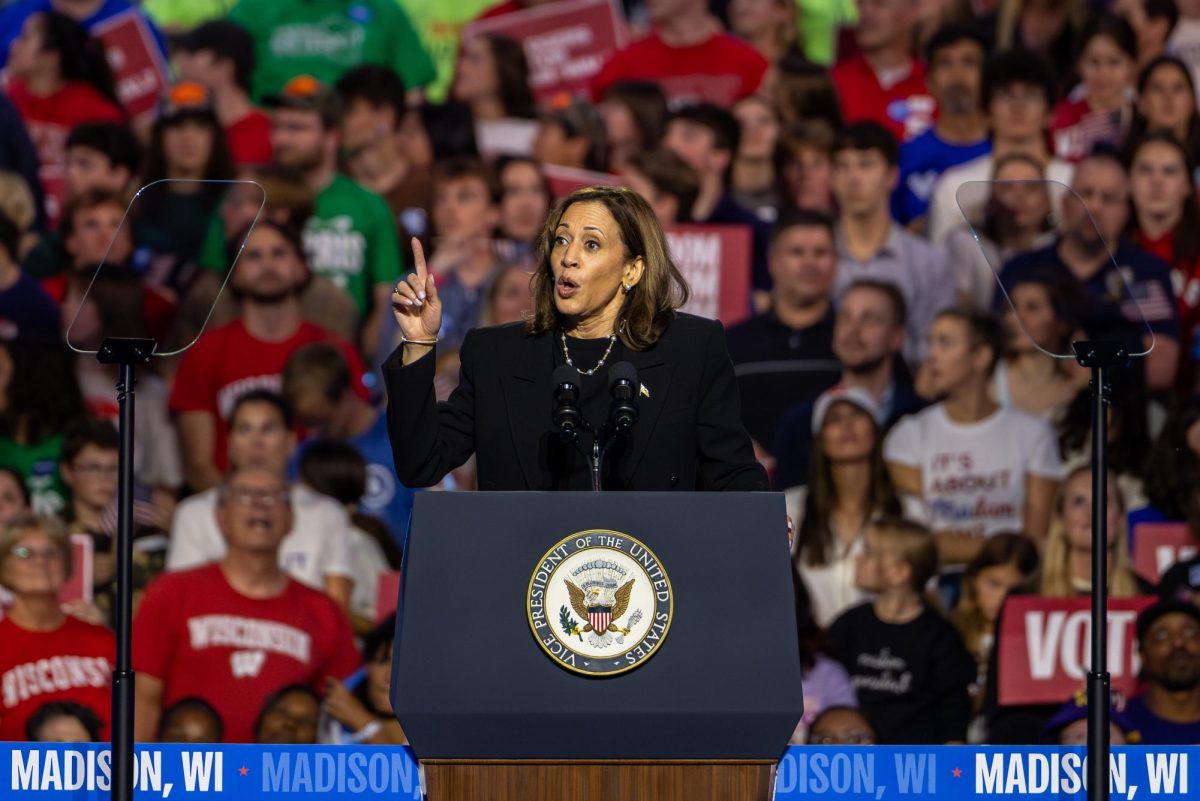As time moves closer to the presidential election, digital advertising, playing into meme culture and foraying into less formal interview settings like podcasts are strategies Vice President Kamala Harris and former President Donald Trump are using to mobilize young voters by displaying authenticity, journalism and mass communication professor Michael Wagner said. With young voters at the forefront of this election, students share just how impactful their attempts are.
In a fractured information environment, presidential campaigns struggle to gain traction with a large number of voters the way they could have 30 years ago, Wagner said. This new environment pushes candidates to develop methods to connect with different audiences, Wagner said.
“In the contemporary information environment, one of the faster growing forms of communication are podcasts, and they’re especially popular with younger people,” Wagner said. “They also have the advantage of giving the candidates a chance to show younger voters that they are authentic.”
Authenticity is something Wagner said is a value highly regarded by young voters more than anyone.
With Harris recently appearing on Alex Cooper’s “Call Her Daddy” podcast and Trump making appearances on a total of eight podcasts, such as Logan Paul’s “Impaulsive” and the business and technology podcast “All-In,” the candidates try communicating authenticity to new or hard-to-reach audiences, Wagner said.
Though both candidates have gone with similar avenues for campaigning, Wagner said the intricacies of their strategies differ.
Harris, who has explored newer mediums like podcasts while also staying in the realm of traditional campaigning with an interview on Fox News, for example, is trying to appeal to as many demographics as she can, Wagner said. Trump does not actively seek new audiences the way Harris does and tries to strengthen the ties he already has in place, Wagner said.
“He [Trump] is saturating the echo chamber,” Wagner said. “Harris is trying to plant new seeds in new fields and hope that they grow in time.”
Director of community outreach of the College Democrats at UW-Madison Jeffrey Messer agreed that the candidates’ strategies differ and said that Harris has been more successful in reaching younger voters.
Messer said Trump’s efforts, including his appearance on Paul’s podcast, don’t necessarily introduce his name to a new audience.
“With Gen Z, there’s a really big gender divide on who people support, where men — white men specifically — are way more likely to support Donald Trump, so that’s that strategy, going on Logan Paul trying to reach that [audience] and then Kamala going on ‘Call Her Daddy’ is trying to reach the other side of that demographic,” Messer said.
UW junior Hudson Brekhus Lavinsky, a Republican studying finance and entrepreneurship, said the opportunity for authenticity is something he’s valued about the less formal campaign strategies like podcasting.
Trump’s appearance on the “All-In” podcast, specifically, revealed new sides to Trump and the one-on-one interview setting didn’t allow him to evade questions, Brekhus Lavinsky said.
“I think a lot of people might think that … he’s a guy who holds these crazy grudges and wants to burn all his enemies to the ground, but I think I came away from listening to that seeing him more as a grandfatherly figure,” Brekhus Lavinsky said.
College Republicans Chairman Thomas Pyle echoed the sentiment that podcasts teach audiences about a candidate’s character.
Pyle said that Harris has been slightly more effective in reaching out to undecided voters, while Trump, who maybe knows he is not as appealing to undecided voters, has been working to ensure his supporter base shows up and commits to the campaign.
Groups who are normally uninterested in politics are more likely to trust influencers for political information, Assistant Professor in the Department of Life Science Communications Sedona Chinn said.
Audiences who typically avoid politics may turn to influencers if they’re overwhelmed by the negativity and polarization in the news, so by networking with influencers, candidates are trying to find these harder-to-reach audiences, Chinn said.
“If you can mobilize some people to vote that don’t normally vote, that can be very impactful,” Chinn said.
Messer said that informal campaigning is a great way to mobilize those voters, particularly those who are younger.
Around 50% of young people, ages 18-29, voted in the 2020 presidential election, according to CIRCLE.
“Yes, some of us read the news, but when we’re in bed at night we’re scrolling on our phones, or on Twitter, TikTok, YouTube, listening to podcasts and all that,” Messer said. “So to better reach the youth candidates have to do informal campaigning.”
Pyle said that while following a candidate on social media or listening to them on a podcast is a great first step to understanding their platform, it’s only the starting point.
“It’s not nearly enough to be informed and to be ready to vote with,” Pyle said. “It’s really important that you go the extra mile. Do your own research … Really understand what matters to you and what matters to the candidates.”



